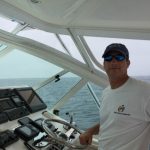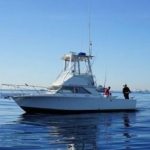Cummins Marine Diesel Repower Specialists › Forums › Cummins Marine Engines › Crankcase ventilation / fumes
- This topic has 20 replies, 6 voices, and was last updated 3 years ago by
Paul Berkshire.
-
CreatorTopic
-
December 19, 2017 at 3:05 pm #26409
Jeff LewisParticipantVessel Name: Happy Ours
Engines: 6BTA5.9M 270hp
Location: Florida
Country: United States
Just purchased Albin with twin 6BTA5.9 270hp engines. Engines ran at 2600 -2650 rpm with normal temps and oil pressures. Oil is venting from starboard engine crankcase vent tube into bilge at normal oil levels (per “hand marked” dip stick). If I let oil go two quarts low (per dip stick), venting stops and oil level remains constant (over the last 10 hrs run time). I’m still getting a lot of fumes in salon (engines are mounted aft with V-drives), unless I use blowers full time. Max rpm has reduced to 2550 – 2575 rpm on both engines. Engines run smooth with no smoking. Am I still getting excessive crankcase pressures / blowby? Should I just install a CCV system? Why have I lost max rpm?
-
CreatorTopic
-
AuthorReplies
-
June 12, 2020 at 6:25 pm #99239
I’m confused but not the first time. You say drain pan and add 12 quarts and mark dipstick . The oil pan capacity chart says the low pan capacity for a 6bta is 13 quarts
December 29, 2017 at 6:46 pm #26656
Tony AthensModeratorVessel Name: Local Banks
Engines: QSB 6.7 550 HP
Location: Oxnard, CA
Country: USA
Jeff,
I go back to the late 80’s dealing with the B and issues with crankcase venting/blow-by……..To this very day, Cummins most recently trained school techs still have no idea what goes on that the extra shallow pan their engineers made for this engine that causes rod dipping in many installations.. ..
The engineers seem to think that all vessels fit the same mold.. They to not, but again, they have no clue……………..Your installation was a perfect example…..
Hope other read this and learn..
Tony
December 29, 2017 at 12:56 pm #26646
PhilipParticipantVessel Name: 2007 35’ Cabo ‘FUGA’
Engines: Cummins QSC8.3-540’s
Location: Long Beach, CA
Great news on the oil levels fixing your venting issue! You would be surprised how often this is seen. The CCV system your going to install will help as well with the fumes etc.
How’s your max RPM issue going?
Phil
December 29, 2017 at 6:48 am #26634
Jeff LewisParticipantVessel Name: Happy Ours
Engines: 6BTA5.9M 270hp
Location: Florida
Country: United States
Before I drained the oil, the port engine oil level was 1/8″ below high mark on dipstick (but no venting issues on this engine). The starboard engine was venting oil badly (1 Qt / hr) when the oil was “between the marks”. It stopped venting oil when the level got to 1/2″ below low level dipstick mark. I drained both engines and found both had near 16 Qt. Previous owner must’ve been running engine 1 gallon overfilled the last 10 years? Anyway, I remarked at 12 Qt. All is fine – I still plan on CCV system (just received it) and rest on Tony’s recommendations.
December 24, 2017 at 11:03 am #26516
PhilipParticipantVessel Name: 2007 35’ Cabo ‘FUGA’
Engines: Cummins QSC8.3-540’s
Location: Long Beach, CA
Jeff,
I’m going to suggest, and I’m sure I will either be corrected or confirmed, that the technical definition of what’s a safe rpm to cruise at is a more complex question than what Cummins is giving you with their rating of continuous duty and recreational use. Cummins is throwing those terms as a measure of engine warranty with a big helping of marketing.
What your interested in boils down to the simple question of what rpm (max boat speed) can I use and expect to have reasonable engine life. That depends on a whole set is assumptions including health of your cooling system, water temperature, engine loading at that rpm, design of your exhaust system, etc, etc.
If you look at what Tony is saying – 160 thermostats, idle pulley upgrade, coolant alarms, and PROP ADJUSTMENT – ask yourself what do these things have in common and what do they mean to how I operate? Simple answers. It means ensure you can get heat out of the engine and if there is an issue I want to know about it before the heat gets high. These things are of utmost importance when you are asking 100%+++ from your engine.
High flow 160 thermostats will help keep the engine operating warm enough to be efficient, get the heat out fast, and have a margin if something goes wrong. That means ~30 degrees of rise before the 195 alarm goes off and you pull back. That’s plenty of margin to not do damage to the engine. So what can go wrong? Look at those idler pulleys and do some reading, they are a weak link and if one fails your cooling system goes to zero and heat rises immediately so we remove that liability with the upgrade. I still recommend at least yearly to remove the belt and give a spin to everything to make sure all is smoooth with no side play etc (idlers, alternator, pump, etc.).
Now for the prop adjustment and this is key. Think of going up a hill on a 10 speed in high gear, you can hardly turn the pedals, your working hard, slowing down as you go, getting hot. Now shift to a lower gear and it becomes easy to pedal, you start to accelerate, your feeling better and getting in your rhythm. This is why we prop down, we want that engine to work easy, not overheat, and have the energy to accelerate to its potential, and do it all safely. This is why you need to get your props adjusted.
Your question of what is max rpm you can cruise at continuously, I’d suggest that without a EGT guage there will be lots of suggestions but we can’t know for sure. Why? Because every exhaust design is different and that affects the EGT’s. High EGTs will affect your turbo life. These diesels are just heat pumps when you boil it all down.
BUT, by doing all the things Tony is suggesting we can be reliably ensured that you are operating safe at ALL RPMs. That doesn’t mean go out and run 100% full time. Most boats have a comfortable cruise speed in your example 6-8 knots. And on occasion if you want to run at 2100-2200 you can do it safely.
Finally your CCV issue can be managed but don’t underestimate the importance of draining your oil pan 100% bone dry, adding 12 qts EXACTLY, and using that as your mark on the dip stick.
Let us know how it goes, we are all here to help!
Phil
December 23, 2017 at 12:52 pm #26505
Jeff LewisParticipantVessel Name: Happy Ours
Engines: 6BTA5.9M 270hp
Location: Florida
Country: United States
Thanks Bill,
I’m starting to get a handle on it. I still would like to know what a “reasonable” cruising rpm is . Cummins just throws out 2400 rpm continuous duty (no more than 300 hrs/yr). This is obviously high. This boat cruises nicely at 2100 – 2200 rpm at 14-16 kts. Is that reasonable for a 100 mile Florida to Bahama run? Best fuel economy is 6 – 8 kts.Rob and Tony, I’ll get some pics after Christmas because I’m still concerned about the crank ventilation and fumes.
Merry Christmas,
JeffDecember 23, 2017 at 7:55 am #26497
Bill FullerParticipantVessel Name: Audax
Engines: Yanmar 4LHA-STE
Location: San Diego, CA
Country: USA
Jeff
I would like to had one more bit of information that I don’t think Tony explicitly covers in his articles and IMO need to be stressed to those who are not familiar with engine ratings etc.Rated RPM (the number on your engine tag) means that your engine is capable of making 270 (260) HP at 2600 RPM and nothing more.
This number has absolutely nothing to do with the maximum allowable RPM that the engine is allowed to turn.
Cummins spec for your engine is that maximum WOT RPM is between 2900 and 3000 (this is what is referred to in spec sheets as the “high Idle”. This is also the governor setting which will not allow your engine to go to any higher RPM.
I hope this helps to clarify why Tony and Rob and others are always saying to prop to rated RPM + 100 or whatever.
Bill
December 21, 2017 at 6:46 pm #26474
Tony AthensModeratorVessel Name: Local Banks
Engines: QSB 6.7 550 HP
Location: Oxnard, CA
Country: USA
Well there it is then,,,,,,,,,
Maybe you realize that a “wine & cheese” cruising speed is more what this boat is about.. ……………..
You now know the engines limits and what is really practical for a vessel like this as to speeds.. Having the ability to travel at 12-16 Kts for very short periods is great, but for the long haul, this is not what this boat is about
All is good. Enjoy the holidays..
Tony
December 21, 2017 at 2:18 pm #26468
Jeff LewisParticipantVessel Name: Happy Ours
Engines: 6BTA5.9M 270hp
Location: Florida
Country: United States
Tony,
I’m not interested in running the boat on the “edge”. I’ve been a military and commercial pilot for thirty years and been primarily a sailor that time. I like to know operational limits, not because I push them, but so I can better understand my aircraft or boat. This is my first experience in big diesels. I’m just trying to figure out how best to use this great boat. So far I’ve primarily cruised between 6-8 kts. On occasion I have run it at 2100 – 2200 rpm and gotten 14-16 kts. I’m trying not to do major changes if I don’t have to. I did purchase a CCV system from Seaboard – haven’t received it yet. I’ll reprop this summer per your instructions.
JeffDecember 21, 2017 at 11:37 am #26466
Tony AthensModeratorVessel Name: Local Banks
Engines: QSB 6.7 550 HP
Location: Oxnard, CA
Country: USA
Jeff,
Since your plan seems to be running the engine at the absolute edge of their capability, and you have a boat that at the higher speeds seems to have the bow rise enough to where you are “whipping oil”, this is what I do:
1) Install hi-flow 160F thermostats
2) Upgrade you idler pulleys on the front of your engine
3) Install a redundant coolant alarm ( 195F is best)
4) Drain your pan 100% dry, add exactly 12 qts to oil to the pan.. Let it sit for 5 minutes, then mark your dip stick LOW.. DIP the stick a few times to insure that mark will be correct –Ignore all the other marks at this time but note where they are.. Never run more than 1/2″ above your new LOW mark, with the low mark your “MAGIC OIL LEVEL” in the pan, engine off.. Notice I did not mention anything about the oil filter, etc.. That has nothing to do with the lever that “sits in your oil pan” when the engine is off.
5) Put a catch bottle on your draft tube to monitor “blow -by” oil for now.. We’ll deal with a proper CCV later.
6) When you get your props done and the prop guy asks–Tell him 260 BHP at 2700 RPM & that is the RPM you want to achieve… Also, you want them “Tuned to Class 1” or better specs.. Remember, you do not want a “flat tire” on a performance car.. Same thing for a boat trying to Plane but is not really designed for it at the weight you are running about at… FYI, your engine rating IS not 270 HP ( that is a old BOGUS metric rating not longer applicable or used) It’s 260 BHP.
Follow up after you have done your “due diligence”..
Tony
..December 21, 2017 at 9:39 am #26464
Jeff LewisParticipantVessel Name: Happy Ours
Engines: 6BTA5.9M 270hp
Location: Florida
Country: United States
Thanks Rob, the graph explains it all.
JeffDecember 21, 2017 at 9:38 am #26463
Jeff LewisParticipantVessel Name: Happy Ours
Engines: 6BTA5.9M 270hp
Location: Florida
Country: United States
Makes sense. The graph Rob supplied explains all. If I reprop to 2700 should I still limit speeds above 2400 to 1 hr in 8 per Cummins? Just got boat. I will change oil next week and let you know how much is in pan. I’m planing on putting 13 qt in.
JeffDecember 21, 2017 at 8:42 am #26460
Rob SchepisForum ModeratorVessel Name: Tenacious
Engines: 6BTA 5.9 330's - "Seaboard Style"
Location: Long Island, NY
Country: USA
Proper Propping (Mechanical Engine)
Here it is on Cummins paper..
December 21, 2017 at 8:17 am #26459
Tony AthensModeratorVessel Name: Local Banks
Engines: QSB 6.7 550 HP
Location: Oxnard, CA
Country: USA
If your cannot make at least an accurate 2600 RPM (and that is under test cell conditions when everything is 100%), you are leaving HP on the table, along with maximum vessel performance
This is not about “cushion”, it’s about allowing your engine to make full power easily & safely………
Prop to reach 2650-2700 with this engine using first class props and your boat with be FASTER at WOT..
As your boat gets lighter burning off fuel it during the day, it will only go faster. .
Oil level in the oil pan sitting at the dock, engine off: What is that number?
Tony
December 21, 2017 at 4:25 am #26456
Jeff LewisParticipantVessel Name: Happy Ours
Engines: 6BTA5.9M 270hp
Location: Florida
Country: United States
Great info Rob,
It thoroughly explains what I’m seeing. The boat was propped at 2650 WOT when I sea trialed it. When I took delivery I filled the tanks (200 gal diesel and 100 gal water – over 2000 lbs) and my WOT rpm obviously dropped 75-100 because of the increased drag. Please correct me if I’m wrong, but if I have the WOT rpm right at 2600 the Cummins Ops Limits (2600 rpm max 1 hour out of 8 hours for a 300 hr/yr pleasure craft and 2400 rpm max continuous) should still keep me “safe”? Re-pitching to 2700 rpm just gives me some cushion and will decrease the load and wear and tear on the engines for the same rpm (but a slower speed).
JeffDecember 20, 2017 at 2:48 pm #26443
Rob SchepisForum ModeratorVessel Name: Tenacious
Engines: 6BTA 5.9 330's - "Seaboard Style"
Location: Long Island, NY
Country: USA
22R/L25
Gotcha, so 22×25’s….
December 20, 2017 at 8:30 am #26439
Jeff LewisParticipantVessel Name: Happy Ours
Engines: 6BTA5.9M 270hp
Location: Florida
Country: United States
Thanks Rob,
Props are 22” dia, 25” pitchDecember 20, 2017 at 6:15 am #26433
Rob SchepisForum ModeratorVessel Name: Tenacious
Engines: 6BTA 5.9 330's - "Seaboard Style"
Location: Long Island, NY
Country: USA
These articles should help understand why you need to be propped to EXCEED rated rpm. What exactly are 22R/L25 props?
December 19, 2017 at 7:02 pm #26420
Jeff LewisParticipantVessel Name: Happy Ours
Engines: 6BTA5.9M 270hp
Location: Florida
Country: United States
Thanks Rob,
Yes it is a 36 Express Trawler. No CCV, just a vinyl tube from vent port down to the bilge. I’ll definitely check the pan oil quantity. As for WOT, I thought the engine specifications are 2600 WOT (I originally got 2650, now 2550).
Am I not in the ballpark of correct WOT? Why would I prop for 2700? I have 22R/L25 props. I’ll get some pics and check side vents in a couple of days. I just ordered the V-drive CCV from Seaboard.
JeffDecember 19, 2017 at 4:35 pm #26414
Rob SchepisForum ModeratorVessel Name: Tenacious
Engines: 6BTA 5.9 330's - "Seaboard Style"
Location: Long Island, NY
Country: USA
Hmmm… an Albin with twin 270’s… must be the 36 Express Trawler?
The 270’s are a 2,600rpm engine so you were a little shy on the WOT RPM even before the drop..
You should have jacket water aftercoolers (JWAC’s) which are almost maintenance free unless they were ingesting dirty oily air which might be the case here.
Sounds like a good plan of attack going forward would be:
1) Get your “oil in the pan” quantity sorted out
2) Install an Envirovent CCV and be sure it is setup for V-Drive application
3) Pull the aftercoolers and have them cleaned via ultrasonic cleaning
4) Get your boat propped so those engines make an easy 2,700 when the boat is FULLY loaded with fluids, gear and persons
And, check your engine room hull side vents – if you indeed have the 36ET the vents are known for crap quality resulting in a salty engine room
Post some good pictures of all including your current CCV and your exhaust.
Here’s the oil pan capacity info:
-
AuthorReplies
You must be logged in to reply to this topic.
